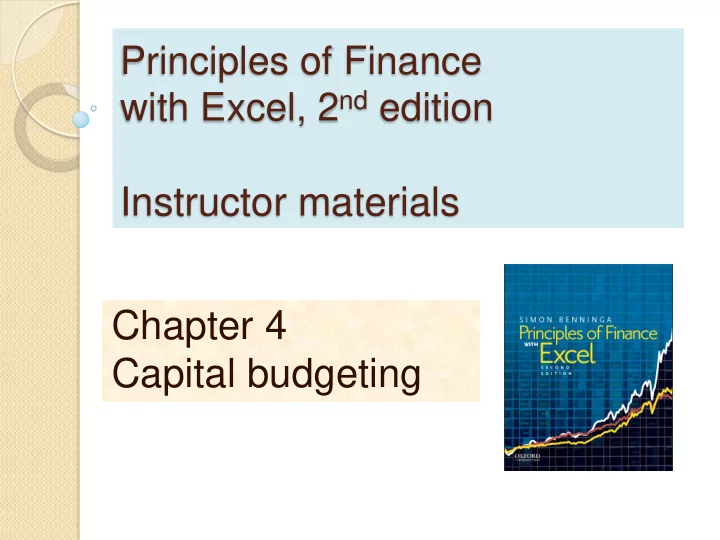

Principles of Finance with Excel, 2 nd edition Instructor materials Chapter 4 Capital budgeting
What is “Capital Budgeting” Two big questions: “Yes-No” : Should you invest money today in a project that gives future payoffs? “Ranking” : How to compare mutually-exclusive projects? If you have several alternative investments, only one of which you can choose, which should you undertake? 2
Other issues Sunk costs. How should we account for costs incurred in the past? The cost of foregone opportunities. Salvage values and terminal values. Incorporating taxes into the valuation decision. This issue is dealt with briefly in Section 4.7. We return to it at greater length in Chapters 4-6. 3
NPV and IRR The two basic capital budgeting tools Note: We usually prefer NPV to IRR, but IRR is a handy tool 4
“Yes-No” and NPV NPV rule: A project is worthwhile if the NPV > 0 > CF CF CF = + + + + = 1 2 N ... 0? NPV CF 0 ( ) ( ) ( ) 1 2 N + + + 1 r 1 r 1 r < According to the NPV rule: If NPV > 0, project is worthwhile If NPV < 0, project should not be undertaken 5
Technical notes CF 0 is usually negative (the project cost) CF 1 , CF 2 , … are usually positive (future payoffs of project) CF 1 , CF 2 , … are expected or anticipated cash flows r is a discount rate appropriate to the project’s risk (see Chapter 6) 6
“Yes-No” and IRR IRR rule: A project is worthwhile if the IRR > discount rate CF CF CF + + + + = 1 2 N CF ... 0 0 ( ) ( ) ( ) 1 2 N + + + 1 1 1 IRR IRR IRR According to the IRR rule: If IRR > r, then the project is worthwhile If IRR < r, project should not be undertaken 7
Basic “Yes-No” example A B C YES-NO WITH NPV AND IRR 1 2 Discount rate 12% 3 Project cash 4 flow Year 5 0 -1000 6 1 300 7 2 400 8 3 500 9 4 600 10 5 100 11 12 NPV 380.68 <-- =B5+NPV($B$2,B6:B10) 13 IRR 26.47% <-- =IRR(B5:B10) This project is worthwhile by both NPV and IRR rules: NPV > 0 IRR > discount rate of 12% 8
Basic “Ranking” example A B C D RANKING TWO PROJECTS WITH NPV AND IRR 1 2 Discount rate 12% 3 4 Year Project A Project B 5 0 -1000 -800 6 1 200 420 7 2 400 100 8 3 600 300 9 4 300 600 10 5 100 200 11 12 NPV 171.92 363.05 <-- =C5+NPV($B$2,C6:C10) 13 IRR 19% 29% <-- =IRR(C5:C10) “Yes-No”: Both projects are worthwhile NPV A , NPV B > 0 IRR A , IRR B > discount rate of 12% “Ranking”: If you can choose only one project, B is preferred by both NPV and IRR NPV B > NPV A IRR B > IRR A 9
Summing up 10
A B C D NPV AND IRR CAN SOMETIMES GIVE CONFLICTING RANKINGS 1 2 Discount rate 6% 3 4 Year Project A Project B 5 0 -500 -500 6 1 100 250 7 2 100 250 8 3 150 200 9 4 200 100 10 5 400 50 11 12 NPV 266.60 242.84 <-- =C5+NPV(B2,C6:C10) 13 IRR 19.77% 27.38% <-- =IRR(C5:C10) In this example: Both A and B are worthwhile by both NPV and IRR criteria If discount rate = 6% A is preferred to B by NPV rule B preferred to A by IRR rule 11
A B C D E F G TABLE OF NPVs AND DISCOUNT RATES 15 Project A Project B 16 NPV NPV 17 0% 450.00 350.00 <-- =$C$5+NPV(A17,$C$6:$C$10) 18 2% 382.57 311.53 <-- =$C$5+NPV(A18,$C$6:$C$10) 19 4% 321.69 275.90 500 20 6% 266.60 242.84 21 8.5128% 204.58 204.58 400 22 10% 171.22 183.49 23 12% 129.85 156.79 300 24 14% 92.08 131.84 25 16% 57.53 108.47 200 26 18% 25.86 86.57 27 20% -3.22 66.00 100 28 22% -29.96 46.66 29 24% -54.61 28.45 0 30 26% -77.36 11.28 0% 5% 10% 15% 20% 25% 30% 31 28% -98.39 -4.93 -100 32 30% -117.87 -20.25 Project A Project B 33 NPV NPV -200 34 IRR A is always < IRR B : By IRR rule, B is always preferred to A For discount rates < 8.5128%: NPV A > NPV B (ranking conflict) For discount rates > 8.51285: NPV A < NPV B (no ranking conflict) 12
When IRR and NPV conflict, use NPV Why: IRR gives the rate of return NPV gives the wealth increment CF CF CF = + + + + 1 2 N NPV CF ... 0 ( ) ( ) ( ) 1 2 N + + + 1 r 1 r 1 r Cost of project Value today of future project cash flows ↑ Incremental wealth: How much does the project's net value add to your wealth? 13
Back to last example: Calculating the crossover point A B C D E CROSSOVER POINT: IRR A = IRR B compute IRR of differential cash flows 1 2 Discount rate 6% 3 Project A - 4 Year Project A Project B Project B 5 0 -500 -500 0 <-- =B5-C5 6 1 100 250 -150 <-- =B6-C6 7 2 100 250 -150 <-- =B7-C7 8 3 150 200 -50 <-- =B8-C8 9 4 200 100 100 <-- =B9-C9 10 5 400 50 350 <-- =B10-C10 11 12 NPV 266.60 242.84 13 IRR 19.77% 27.38% 8.5128% <-- =IRR(D5:D10) Crossover point is the IRR of the differential cash flows (column D) 14
Recommend
More recommend